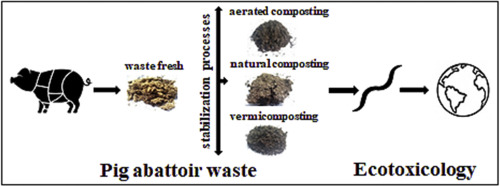Environmental Pollution ( IF 8.9 ) Pub Date : 2020-01-22 , DOI: 10.1016/j.envpol.2020.113928 Maiara Figueiredo Ramires 1 , Eduardo Lorensi de Souza 2 , Márlon de Castro Vasconcelos 2 , Bárbara Estevão Clasen 2 , Daniel Erison Fontanive 2 , Renan Bianchetto 2 , Júlio Cesar Grasel Cezimbra 2 , Zaida Inês Antoniolli 1

|
Due to high global demand, large amounts of abbattoir waste are generated from pork production. Mismanagement of abattoir waste on agricultural lands can result in soil and water contamination with pathogens and contaminants like metals and nutrients. Therefore, possible effects on soil organisms prior to application should be evaluated. Thus, the aim of this study was to determine the effects of fresh pig abattoir waste (PAWf) and waste after stabilization processes on E. andrei through tests of avoidance behavior, acute toxicity and chronic toxicity. In order to do this, the waste was evaluated fresh (i.e., non-treated), and after aerated composting (PAWa), natural composting (PAWn) and vermicomposting (PAWv). In addition, we used a natural soil with no history of agricultural use as control soil. The evaluation was based on avoidance behavior, mortality, initial and final earthworm weight, and reproduction, in addition to a set of enzyme assays formed by acetylcholinesterase, lipid peroxidation, catalase and glutathione S-transferase measured over time. The ecotoxicological results showed that PAWf and PAWa increased AChE activity at different experimental periods, while PAWn decreased activity at 14 days compared to the control. PAWf and PAWa increased TBARS levels at 7 and 14 days, respectively. CAT activity decreased at 3, 7 and 14 days in PAWv, while GST activity increased at 3 days in PAWa and at 3 and 14 days in PAWf compared to the control. In the acute toxicity test, PAWa and PAWn had a toxic effect on E. andrei, resulting in 100% mortality at 14 days of exposure. Based on our findings, pig abattoir waste should undergo vermicomposting prior to agricultural application to soils.
中文翻译:

Eisenia andrei猪屠宰场废物的酶测定和毒性。
由于全球需求旺盛,猪肉生产产生了大量的屠宰场废物。农业土地上屠宰场废物管理不善可能导致土壤和水污染病原体以及诸如金属和养分等污染物。因此,应评估施用前对土壤生物的可能影响。因此,本研究的目的是确定新鲜猪屠宰场废物(PAWf)和稳定过程后的废物对大肠杆菌的影响。通过回避行为,急性毒性和慢性毒性的测试。为此,对废物进行了新鲜评估(即未处理),并在充气堆肥(PAWa),自然堆肥(PAWn)和ver堆肥(PAWv)之后进行了评估。另外,我们使用没有农业使用历史的天然土壤作为对照土壤。评估基于回避行为,死亡率,initial的初始和最终重量以及繁殖,以及随时间测量的由乙酰胆碱酯酶,脂质过氧化,过氧化氢酶和谷胱甘肽S-转移酶形成的一组酶测定。生态毒理学结果表明,与对照相比,PAWf和PAWa在不同的实验时期增加了AChE活性,而PAWn在14天时降低了活性。PAWf和PAWa分别在7天和14天增加了TBARS水平。与对照组相比,PAWv中的CAT活性在第3、7和14天下降,而PAWa中的第3天和PAWf的第3和14天GST活性增加。在急性毒性试验中,PAWa和PAWn对E. andrei,导致暴露14天时100%死亡率。根据我们的发现,在农业应用于土壤之前,应对猪屠宰场的废物进行堆肥。


























 京公网安备 11010802027423号
京公网安备 11010802027423号